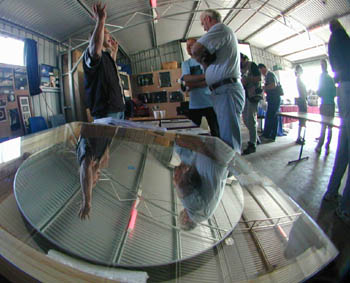Dave's 16 Inch Binocular Telescope Page
David, a electronics engineer from Auckland, has been interested in astronomy since looking at the dark country sky’s while rock climbing over seven years ago. He started with a 4.5” commercially build Meade then built his first telescope a 12.5” three years ago. Now several years later he has a collection of a pair of 7x50 binoculars a 12.5” (304mm) truss tube Dobsonian, with the latest creation being the16” BiNewt (Binocular Newtonian) or a 220mag x 408mm pair of binoculars .
The defining moment to embark on this amazing project occurred at the “South Pacific Star Party” at Wiruna, three hours drive outside Sydney, in March 2003. David was perusing a mirror maker’s stand and came across Mark Suchting who was showing off a 16” mirror, all bright and shiny. He paused long enough to look through a photo album and there on the last page was Clive Milne’s 20” Binoculars. He didn’t quite know what to make of this at first other than to know that it was huge and impressive. After long hours talking to Mark about spectacular views, increased contrast, ease of viewing and the “wow” factor, David finally knew that the Binocular Newtonian was the only way to go.
 Size was the next question and since David had used a 12.5” for several years something larger was required. However as with everything compromise plays its part. Huge mirrors mean huge weights, costs, difficulty in transport and setup, and the bigger the mirror diameter the higher the eyepiece is from the ground. To the point you start needing tall ladders, in the dark, to see through the eyepiece, you get to fear the climb. Mirror diameters of twenty inches were thought about but this created a need to get into ladder games in a serious way. Remember that you look down into the instrument from the top and see the sky over your shoulders behind you. The light grasp would be great with the 16” F5, and with only a slightly longer focal length than the 12.5”, it seemed to be the dream size.
Size was the next question and since David had used a 12.5” for several years something larger was required. However as with everything compromise plays its part. Huge mirrors mean huge weights, costs, difficulty in transport and setup, and the bigger the mirror diameter the higher the eyepiece is from the ground. To the point you start needing tall ladders, in the dark, to see through the eyepiece, you get to fear the climb. Mirror diameters of twenty inches were thought about but this created a need to get into ladder games in a serious way. Remember that you look down into the instrument from the top and see the sky over your shoulders behind you. The light grasp would be great with the 16” F5, and with only a slightly longer focal length than the 12.5”, it seemed to be the dream size.
Mark Suchting then suggested plate glass as an option. The belief that plate was an inferior material mainly due to its poor heat expansion properties was refuted by Mark, who pointed out that the price of the blanks was far less; the heat expansion problems affected the mirror maker more than the user; and by using 30mm plate the cooling would be much faster due to the lower mass. The weight of a thin glass would also make it much easier to assemble the telescope. So far this seems to have been proved true with stunning views every time.
The flight home from Sydney was filled with sketches of mirror cells, rotating tops, and focal ratios. Less than a week later the two sixteen inch (408mm) F5 plate mirrors were ordered from Mark. The fun was about to begin!
This site is hosted free by another great New Zealand Company
 |